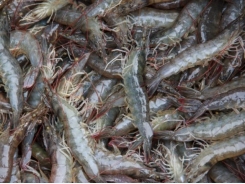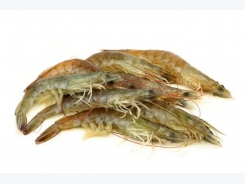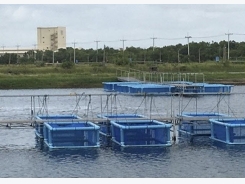Seaweed additive may support shrimp survival after cold shock

Adding seaweed to shrimp feed may improve membrane fluidity and immune functioning allowing shrimp to better weather temperature flux, say researchers.
A team of Brazil-based researchers from the Federal University of Santa Catarina and the Federal Institute of Catarinense examined the use of brown seaweed (Sargassum fiilipendula) in the diets of farm-raised shrimp exposed to cold temperatures to explore what mechanism might be altered by the additive.
The group published its work in the journal Aquaculture.
“In the present work, we used MALDI-TOF MS [matrix-assisted laser desorption/ionization time of flight mass spectrometry] to assess protein and lipid profiles of intact and lysed hemocytes from Pacific white shrimp, L. vannamei, fed 0.5% of S. filipendula and submitted to thermal shock,” the researchers said.
The team found that adding 0.5% of the seaweed to the diet altered profiles for lipids and proteins in shrimp hemocytes, the researchers said. “Molecular profiles herein described agree with previous data from different analytical platforms and show that thermal shock resistance, as demonstrated by shrimps fed with S. filipendula, is associated with the increase of membrane fluidity and antimicrobial defenses, the mitigation of oxidative stress and stress-induced cell death, and the differential modulation of energy metabolism and DNA regulation,” they added.
The changes may help explain how shrimp receiving the feed additive seaweed were better able to survive thermal shock, said the researchers.
Why brown seaweed?
Brown seaweed offers a high nutritional value and contains several bioactive elements, said the researchers. Its use as a feed ingredient has expanded in recent years.
In other species, like the poikilothermic worm, another type of brown seaweed was found to boost thermal resistance, they said. But results have not always been consistent across types of brown seaweed.
A previous study done by the researchers demonstrated that Pacific white shrimp given 0.5 or 2% inclusion of the brown seaweed (Sargassum filipendula) were more likely to survive a cold shock. “Whereas increasing levels of the brown seaweed Undaria pinnatifida had the opposite effect on shrimp resistance to thermal shock,” they said.
Cold stress has been linked to several physiological impairments for poikilothermic species, they said. These include disrupting the integrity of proteins and membranes, generating mitochondrial respiration malfunctions and oxidative stress.
For shrimp producers, cold stress can result in loss of productivity as shrimp may be more susceptible to disease and have reduced growth, said the researchers. In Brazil, disease has been a factor for the shrimp farming sector resulting in large production losses.
“The weather in Southern Brazil is quite unstable, showing high temperature fluctuation during crop seasons, and this fluctuation, in turn, plays an important role as a natural trigger for disease outbreaks,” the researchers said. Shrimp are sensitive to changes in temperature as they do not manage their internal temperatures, they added.
Some insects have developed the ability to resist colder temperatures through processes like the upregulation of aquaporins, use of detoxification enzymes and heat shock proteins, which improve water movement on the cellular level, reduce oxidative stress and reduce protein denaturation, they said.
Cold-hardy insects also often can change their metabolism to inhibit aerobic processes and stimulate a glycolytic one, they said. Other biochemical processes improve membrane fluidity.
“Reduced membrane fluidity during chilling is very harmful to cell functioning since it immobilizes membrane proteins and impairs cell signaling and nutrient/ion transport,” said the researchers. “Membrane homeoviscous adaptation is an important mechanism for cold resistance.”
However, cold-intolerant animals may see improvement from feed supplementation – as in the case of fish offered levels of l-carnitine or seabream fed taurine, l-betaine, vitamin C and unsaturated phospholipids, they said.
“We found increased thermal shock resistance of this species based on feed supplementation with S. filipendula,” they said. “Since the biochemical and proximate composition analyses of the seaweeds did not allow any conclusion, this result raised questions about the mechanisms responsible for such resistance.”
Study details
In the feeding trial, shrimp were given one of two diets for a period of 15 days, the researchers said. The diets included a control, and a diet with 0.5% seaweed dry biomass in place of some kaolin.
On day 16, 40 shrimp from both groups were exposed to a cold stress, they said. Shrimp were then moved back to a warmer tank and observed for 24 hours.
The MALDI-TOF MS analyses were done at multiple times – for shrimp on both diets prior to the thermal shock and again 15 minutes after it took place, they said. Samples for the test were taken from 10 animals per diet.
The tests were checked for changes and lipid profiles were established, they said.
Results
Animals on the control diet were found to have higher mortality rates after the thermal shock, said the researchers.
Control group shrimp saw about 20% mortality, while those getting the seaweed supplement had a 3% mortality rate, they said.
Analysis of samples collected found that shrimp myocytes for lipids and proteins varied the most, they said. The changes and increased survival rate for shrimp receiving the feed additive was attributed to increased membrane fluidity and improved antimicrobial defenses.
“It can be concluded that S. filipendula increased membrane fluidity and antimicrobial defense, diminished apoptotic signaling, and modulated DNA regulation, lipid and energy metabolism of shrimp hemocytes,” the researchers said. “These mechanisms could explain, at least in part, the higher thermal shock resistance of these shrimp fed a diet with 0.5% S. filipendula.”
Related news
Tools

Phối trộn thức ăn chăn nuôi

Pha dung dịch thủy canh

Định mức cho tôm ăn

Phối trộn phân bón NPK

Xác định tỷ lệ tôm sống

Chuyển đổi đơn vị phân bón

Xác định công suất sục khí

Chuyển đổi đơn vị tôm

Tính diện tích nhà kính

Tính thể tích ao




 Mealworms on the menu for farmed shrimp?
Mealworms on the menu for farmed shrimp?  Prawn potential: Ridley feed trial in Thailand successful
Prawn potential: Ridley feed trial in Thailand successful